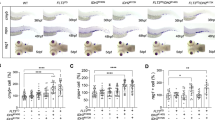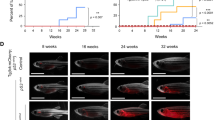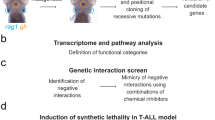Abstract
T-cell acute lymphoblastic leukemia (T-ALL) is a challenging clinical entity with high rates of induction failure and relapse. To discover the genetic changes occurring in T-ALL, and those contributing to relapse, we studied zebrafish (Danio rerio) T-ALL samples using array comparative genomic hybridization (aCGH). We performed aCGH on 17 T-ALLs from four zebrafish T-ALL models, and evaluated similarities between fish and humans by comparing all D. rerio genes with copy number aberrations (CNAs) with a cohort of 75 published human T-ALLs analyzed by aCGH. Within all D. rerio CNAs, we identified 893 genes with human homologues and found significant overlap (67%) with the human CNA dataset. In addition, when we restricted our analysis to primary T-ALLs (14 zebrafish and 61 human samples), 10 genes were recurrently altered in >3 zebrafish cancers and ⩾4 human cases, suggesting a conserved role for these loci in T-ALL transformation across species. We also conducted iterative allo-transplantation with three zebrafish malignancies. This technique selects for aggressive disease, resulting in shorter survival times in successive transplant rounds and modeling refractory and relapsed human T-ALL. Fifty-five percent of original CNAs were preserved after serial transplantation, demonstrating clonality between each primary and passaged leukemia. Cancers acquired an average of 34 new CNAs during passaging. Genes in these loci may underlie the enhanced malignant behavior of these neoplasias. We also compared genes from CNAs of passaged zebrafish malignancies with aCGH results from 50 human T-ALL patients who failed induction, relapsed or would eventually relapse. Again, many genes (88/164) were shared by both datasets. Further, nine recurrently altered genes in passaged D. rerio T-ALL were also found in multiple human T-ALL cases. These results suggest that zebrafish and human T-ALLs are similar at the genomic level, and are governed by factors that have persisted throughout evolution.
This is a preview of subscription content, access via your institution
Access options
Subscribe to this journal
Receive 50 print issues and online access
$259.00 per year
only $5.18 per issue
Buy this article
- Purchase on Springer Link
- Instant access to full article PDF
Prices may be subject to local taxes which are calculated during checkout



Similar content being viewed by others
References
Armstrong SA, Look AT . (2005). Molecular genetics of acute lymphoblastic leukemia. J Clin Oncol 23: 6306–6315.
Chen J, Jette C, Kanki JP, Aster JC, Look AT, Griffin JD . (2007). NOTCH1-induced T-cell leukemia in transgenic zebrafish. Leukemia 21: 462–471.
Choi S, Henderson MJ, Kwan E, Beesley AH, Sutton R, Bahar AY et al. (2007). Relapse in children with acute lymphoblastic leukemia involving selection of a preexisting drug-resistant subclone. Blood 110: 632–639.
Frazer JK, Meeker ND, Rudner L, Bradley DF, Smith AC, Demarest B et al. (2009). Heritable -cel T-cell malignancy models established in a zebrafish phenotypic screen. Leukemia 23: 1825–1835.
Freeman JL, Ceol C, Feng H, Langenau DM, Belair C, Stern HM et al. (2009). Construction and application of a zebrafish array comparative genomic hybridization platform. Genes Chromosomes Cancer 48: 155–170.
Gutierrez A, Dahlberg SE, Neuberg DS, Zhang J, Grebliunaite R, Sanda T et al. (2010a). Absence of biallelic TCRgamma deletion predicts early treatment failure in pediatric T-cell acute lymphoblastic leukemia. J Clin Oncol 28: 3816–3823.
Gutierrez A, Sanda T, Ma W, Zhang J, Grebliunaite R, Dahlberg S et al. (2010b). Inactivation of LEF1 in T-cell acute lymphoblastic leukemia. Blood 115: 2845–2851.
Haire RN, Rast JP, Litman RT, Litman GW . (2000). Characterization of three isotypes of immunoglobulin light chains and T-cell antigen receptor alpha in zebrafish. Immunogenetics 51: 915–923.
Hodgson G, Hager JH, Volik S, Hariono S, Wernick M, Moore D et al. (2001). Genome scanning with array CGH delineates regional alterations in mouse islet carcinomas. Nat Genet 29: 459–464.
Langenau DM, Feng H, Berghmans S, Kanki JP, Kutok JL, Look AT . (2005). Cre/lox-regulated transgenic zebrafish model with conditional myc-induced T cell acute lymphoblastic leukemia. Proc Natl Acad Sci USA 102: 6068–6073.
Langenau DM, Keefe MD, Storer NY, Guyon JR, Kutok JL, Le X et al. (2007). Effects of RAS on the genesis of embryonal rhabdomyosarcoma. Genes Dev 21: 1382–1395.
Langenau DM, Traver D, Ferrando AA, Kutok JL, Aster JC, Kanki JP et al. (2003). Myc-induced T cell leukemia in transgenic zebrafish. Science 299: 887–890.
Maydan JS, Flibotte S, Edgley ML, Lau J, Selzer RR, Richmond TA et al. (2007). Efficient high-resolution deletion discovery in Caenorhabditis elegans by array comparative genomic hybridization. Genome Res 17: 337–347.
Meeker ND, Smith AC, Frazer JK, Bradley DF, Rudner LA, Love C et al. (2010). Characterization of the zebrafish T cell receptor beta locus. Immunogenetics 62: 23–29.
Mione MC, Trede NS . (2010). The zebrafish as a model for cancer. Dis Model Mech 3: 517–523.
Mullighan CG, Goorha S, Radtke I, Miller CB, Coustan-Smith E, Dalton JD et al. (2007). Genome-wide analysis of genetic alterations in acute lymphoblastic leukaemia. Nature 446: 758–764.
Mullighan CG, Phillips LA, Su X, Ma J, Miller CB, Shurtleff SA et al. (2008). Genomic analysis of the clonal origins of relapsed acute lymphoblastic leukemia. Science 322: 1377–1380.
Panzer-Grumayer ER, Cazzaniga G, van der Velden VH, del Giudice L, Peham M, Mann G et al. (2005). Immunogenotype changes prevail in relapses of young children with TEL-AML1-positive acute lymphoblastic leukemia and derive mainly from clonal selection. Clin Cancer Res 11: 7720–7727.
Patton EE, Widlund HR, Kutok JL, Kopani KR, Amatruda JF, Murphey RD et al. (2005). BRAF mutations are sufficient to promote nevi formation and cooperate with p53 in the genesis of melanoma. Curr Biol 15: 249–254.
Peterson SM, Freeman JL . (2009). Cancer cytogenetics in the zebrafish. Zebrafish 6: 355–360.
Pinkel D, Albertson DG . (2005). Comparative genomic hybridization. Annu Rev Genomics Hum Genet 6: 331–354.
Remke M, Pfister S, Kox C, Toedt G, Becker N, Benner A et al. (2009). High-resolution genomic profiling of childhood T-ALL reveals frequent copy-number alterations affecting the TGF-beta and PI3K-AKT pathways and deletions at 6q15-16.1 as a genomic marker for unfavorable early treatment response. Blood 114: 1053–1062.
Ren M, Li X, Cowell JK . (2009). Genetic fingerprinting of the development and progression of T-cell lymphoma in a murine model of atypical myeloproliferative disorder initiated by the ZNF198-fibroblast growth factor receptor-1 chimeric tyrosine kinase. Blood 114: 1576–1584.
Rudner LA, Frazer JK, Trede NS . (2010). Modeling human hematologic malignancies in zebrafish: a review. Curr TrendsImmunol 10: 119–134.
Sabaawy HE, Azuma M, Embree LJ, Tsai HJ, Starost MF, Hickstein DD . (2006). TEL-AML1 transgenic zebrafish model of precursor B cell acute lymphoblastic leukemia. Proc Natl Acad Sci USA 103: 15166–15171.
Schorpp M, Bialecki M, Diekhoff D, Walderich B, Odenthal J, Maischein HM et al. (2006). Conserved functions of Ikaros in vertebrate lymphocyte development: genetic evidence for distinct larval and adult phases of T cell development and two lineages of B cells in zebrafish. J Immunol 177: 2463–2476.
Smith AC, Raimondi AR, Salthouse CD, Ignatius MS, Blackburn JS, Mizgirev IV et al. (2010). High-throughput cell transplantation establishes that tumor-initiating cells are abundant in zebrafish T-cell acute lymphoblastic leukemia. Blood 115: 3296–3303.
Sulong S, Moorman AV, Irving JA, Strefford JC, Konn ZJ, Case MC et al. (2009). A comprehensive analysis of the CDKN2A gene in childhood acute lymphoblastic leukemia reveals genomic deletion, copy number neutral loss of heterozygosity, and association with specific cytogenetic subgroups. Blood 113: 100–107.
Thomas R, Duke SE, Bloom SK, Breen TE, Young AC, Feiste E et al. (2007). A cytogenetically characterized, genome-anchored 10-Mb BAC set and CGH array for the domestic dog. J Hered 98: 474–484.
Vago L, Perna SK, Zanussi M, Mazzi B, Barlassina C, Stanghellini MT et al. (2009). Loss of mismatched HLA in leukemia after stem-cell transplantation. N Engl J Med 361: 478–488.
Van Vlierberghe P, Palomero T, Khiabanian H, Van der Meulen J, Castillo M, Van Roy N et al. (2010). PHF6 mutations in T-cell acute lymphoblastic leukemia. Nat Genet 42: 338–342.
Weng AP, Ferrando AA, Lee W, Morris JPt, Silverman LB, Sanchez-Irizarry C et al. (2004). Activating mutations of NOTCH1 in human T cell acute lymphoblastic leukemia. Science 306: 269–271.
Weng AP, Millholland JM, Yashiro-Ohtani Y, Arcangeli ML, Lau A, Wai C et al. (2006). c-Myc is an important direct target of Notch1 in T-cell acute lymphoblastic leukemia/lymphoma. Genes Devel 20: 2096–2109.
Acknowledgements
We thank Brett Milash for bioinformatics analyses, Ken Boucher for statistical expertise, and Bradley Demarest for assistance with figure preparation. NST was supported by NIAID award R21-AI079784 and the Huntsman Cancer Foundation. JKF was supported by Eunice Kennedy Shriver NICHD award K08-HD053350, the CHRC at the University of Utah, and the PCMC Foundation. Huntsman Cancer Institute core facilities supported by NCI P30-CA042014 also contributed to this work.
Author information
Authors and Affiliations
Corresponding author
Ethics declarations
Competing interests
The authors declare no conflict of interest.
Additional information
Supplementary Information accompanies the paper on the Oncogene website
Rights and permissions
About this article
Cite this article
Rudner, L., Brown, K., Dobrinski, K. et al. Shared acquired genomic changes in zebrafish and human T-ALL. Oncogene 30, 4289–4296 (2011). https://doi.org/10.1038/onc.2011.138
Received:
Revised:
Accepted:
Published:
Issue Date:
DOI: https://doi.org/10.1038/onc.2011.138
Keywords
This article is cited by
-
Simultaneous B and T cell acute lymphoblastic leukemias in zebrafish driven by transgenic MYC: implications for oncogenesis and lymphopoiesis
Leukemia (2019)
-
Systems glycomics of adult zebrafish identifies organ-specific sialylation and glycosylation patterns
Nature Communications (2018)
-
Zebrafish as a model for leukemia and other hematopoietic disorders
Journal of Hematology & Oncology (2015)
-
Danio rerio: Small Fish Making a Big Splash in Leukemia
Current Pathobiology Reports (2014)



